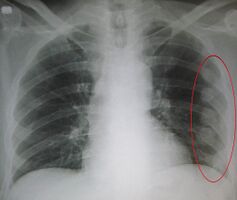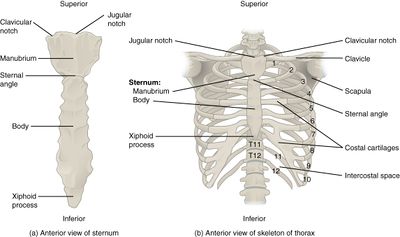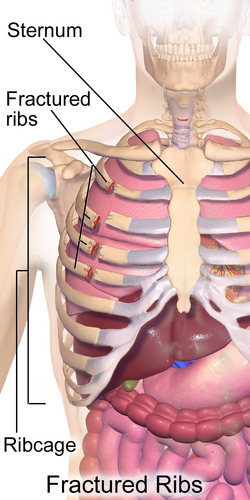Rib Fracture: Difference between revisions
No edit summary |
Kim Jackson (talk | contribs) No edit summary |
||
| (12 intermediate revisions by 2 users not shown) | |||
| Line 1: | Line 1: | ||
<div class=" | <div class="editorbox">'''Original Editor '''- [[User:Lucinda hampton|Lucinda hampton]] | ||
</div> | '''Top Contributors''' - {{Special:Contributors/{{FULLPAGENAME}}}}</div> | ||
== Introduction == | == Introduction == | ||
[[File: | [[File:Fracturedribsmarked.jpeg|thumb|237x237px|Multiple old fractured ribs L side marked. ]] | ||
[[Ribs|Rib]] fractures occur when a significant enough force directed at the rib causes a break. | [[Ribs|Rib]] fractures occur when a significant enough force directed at the rib causes a break. Rib [[Fracture|fractures]] are often associated with other injuries and the greater the number of rib fractures the more likely are associated injuries <ref name=":3">Radiopedia [https://radiopaedia.org/articles/rib-fractures Rib fractures] Available: https://radiopaedia.org/articles/rib-fractures<nowiki/>(accessed 10.3.2022)</ref> Rib fractures can occur at any age, but [[Older People - An Introduction|older people]] are at higher risk because of [[osteoporosis]]<ref name=":4" /> | ||
Rib fractures are most often treated with [[Pain Medications|pain management]] and [[Diaphragmatic Breathing Exercises|breathing exercises]] to prevent complication and additional damage to [[Lung Anatomy|lung]]<nowiki/>s.<ref name=":4">Baiu I, Spain D. [https://jamanetwork.com/journals/jama/fullarticle/2733210 Rib fractures.] JAMA. 2019 May 14;321(18):1836-.Available: https://jamanetwork.com/journals/jama/fullarticle/2733210<nowiki/>(accessed 10.3.2022)</ref> | |||
For Clinically Relevant Anatomy see [[Ribs]] | |||
== | == Pathology == | ||
[[File:Rib. | [[File:Rib Cage.jpg|400x400px|alt=|thumb|Rib cage]] | ||
Fractures of the: | |||
* | |||
* 4th-10th ribs are the most common | |||
* 1st-3rd ribs are associated with high-energy trauma | |||
When the rib is fractured: | |||
* Twice, the term floating rib is used to describe the free fracture fragment | |||
* Thrice or more, contiguous floating ribs are present this is called a [[Flail Chest|flail chest]].<ref name=":3" /> | |||
== Etiology == | == Etiology == | ||
[[File:Fractured Ribs.png|right|frameless|alt=|500x500px]]Include: | |||
* Blunt and penetrating trauma: e.g. motor vehicle accidents, [[Falls in elderly|falls]], assaults - most common injury is blunt [[Thoracic Anatomy|thoracic]] trauma, occurring in 50% of cases | |||
* Pathological fractures eg [[Osteoporosis]], malignancies. | * Pathological fractures eg [[Osteoporosis]], malignancies. | ||
* [[Rib stress fracture in rowers|Stress fractures]]: occur more commonly in high-level athletes eg rowers, see image R | * [[Rib stress fracture in rowers|Stress fractures]]: occur more commonly in high-level athletes eg rowers, see image R | ||
* | * Child abuse | ||
* Cardiopulmonary resuscitation (CPR): occurs in 1 in 3 5 | * Cardiopulmonary resuscitation (CPR): occurs in 1 in 3 5 | ||
* Fetal rib [[Fracture|fractures]]: caused by skeletal dysplasias | * Fetal rib [[Fracture|fractures]]: caused by skeletal dysplasias | ||
* Radiation-induced rib fractures 8-9 | * [[Radiation Side Effects and Syndromes|Radiation]]-induced rib fractures 8-9 | ||
* Spontaneous | * Spontaneous rib fracture<ref name=":2">Radiopedia [https://radiopaedia.org/articles/rib-fractures Rib Fractures] Available from:https://radiopaedia.org/articles/rib-fractures (last accessed 5.5.2020)</ref> | ||
== Clinical Presentation == | == Clinical Presentation == | ||
The most common symptom of rib fractures is pain with touch, taking a deep breath, sneezing, or coughing. As these fractures are quite painful, patients take short shallow breaths, and minimize movement. This can lead to collapse of the [[alveoli]] in the lungs, which makes breathing even harder and can subsequently lead to [[pneumonia]].<ref name=":4" /> | |||
Possible presenting symptoms: | Possible presenting symptoms: | ||
* Ache in the ribs that is particularly prominent at night or first thing in the morning (particularly the first few days following injury). | * Ache in the ribs that is particularly prominent at night or first thing in the morning (particularly the first few days following injury). | ||
* Pain may increase when lying on the affected side, applying pressure to the rib region or on firmly touching the rib at the site of injury. | * Pain may increase when lying on the affected side, applying pressure to the rib region or on firmly touching the rib at the site of injury. | ||
* Pain during movements of the upper back such as bending or twisting, or sometimes during certain activities of the upper limb (such as overhead activities, or during heavy pushing, pulling or lifting)<ref name=":1" | * Pain during movements of the upper back such as bending or twisting, or sometimes during certain activities of the upper limb (such as overhead activities, or during heavy pushing, pulling or lifting)<ref name=":1">Physioadvisor.com [https://www.physioadvisor.com.au/injuries/upper-back-chest/rib-fracture/ Rib Fracture] Available from:https://www.physioadvisor.com.au/injuries/upper-back-chest/rib-fracture/ (last accessed 5.5.2020)</ref>. | ||
== Diagnostic Procedures == | == Diagnostic Procedures == | ||
A thorough subjective and objective examination from a physiotherapist is important to assist with diagnosis of a fractured rib | A thorough subjective and objective examination from a physiotherapist is important to assist with diagnosis of a fractured rib | ||
However to determine the likelihood of associated damage to other organs such as the lungs (e.g. a pneumothorax), liver, spleen or kidneys. Investigations such as an X-ray, MRI or CT scan may be performed to confirm diagnosis<ref name=":1" />. | However to determine the likelihood of associated damage to other organs such as the lungs (e.g. a [[pneumothorax]]), [[Liver Disease|liver]], spleen or [[Kidney|kidneys]]. Investigations such as an [[X-Rays|X-ray]], [[MRI Scans|MRI]] or [[CT Scans|CT]] scan may be performed to confirm diagnosis<ref name=":1" />. | ||
# Plain radiograph - may miss up to 50% of rib fractures even with dedicated oblique rib projections | # Plain radiograph - may miss up to 50% of rib fractures even with dedicated oblique rib projections | ||
# CT - more sensitive than plain radiography for the detection of rib fractures | # CT - more sensitive than plain radiography for the detection of rib fractures | ||
# Ultrasound - | # [[Ultrasound Scans|Ultrasound]] - more sensitive and specific than conventional radiography for rib fracture detection in blunt trauma when performed by a trained clinician<ref name=":2" /> | ||
== Outcome Measures == | == Outcome Measures == | ||
| Line 71: | Line 59: | ||
Rib fractures themselves are treated symptomatically and have a good prognostic outcome. | Rib fractures themselves are treated symptomatically and have a good prognostic outcome. | ||
* For simple, isolated rib fractures, conservative therapy is usually adequate which includes appropriate analgesia, rest, and ice. The use of an incentive spirometer should be encouraged to prevent pulmonary atelectasis and splinting. Intercostal nerve blocks can also be applied to aid in pain control. Rib taping is no longer the recommended treatment as it can impede inspiratory effort<ref name=":0" />. | * For simple, isolated rib fractures, conservative therapy is usually adequate which includes appropriate analgesia, rest, and ice. The use of an [[Incentive Spirometry|incentive spirometer]] should be encouraged to prevent pulmonary [[atelectasis]] and splinting. Intercostal nerve blocks can also be applied to aid in pain control. Rib taping is no longer the recommended treatment as it can impede inspiratory effort<ref name=":0">Kuo K, Kim AM. [https://www.ncbi.nlm.nih.gov/books/NBK541020/ Rib Fracture].Available from:https://www.ncbi.nlm.nih.gov/books/NBK541020/ (last accessed 5.5.2020)</ref>. | ||
* If the broken ribs are bent or displaced in such a way that they puncture the lungs, [[Surgery and General Anaesthetic|surgery]] might be needed to put the ribs back together using thin steel plates (called rib plating). Similarly, flail chest may require surgical rib fixation. | |||
* Rib fractures can take up to 3 months to fully heal. | |||
= | Treatment of rib fractures is considered completed when a patient can take deep breaths, cough effectively, and walk without significant discomfort.<ref name=":4" /> | ||
== Associations == | |||
Rib fractures are often associated with other injuries and the greater the number of rib fractures the more likely are associated injuries: | |||
* [[Brachial plexus injury|brachial plexus]] or subclavian vessel injuries (1st-3rd rib fractures) | |||
* pneumothorax/haemothorax | |||
* pulmonary laceration | |||
* lung herniation | |||
* liver, kidney and spleen traumatic injuries (10th-12th rib fractures)<ref name=":2" /> | |||
Aside from immediate traumatic complications outlined above [[atelectasis]] and [[pneumonia]] may develop, mainly due to poor respiratory effort secondary to pain, and this increases the morbidity and mortality due to rib fractures<br> | |||
== Physiotherapy == | == Physiotherapy == | ||
| Line 84: | Line 80: | ||
* education | * education | ||
* rest from aggravating activities | * rest from aggravating activities | ||
* [[dry needling]] | * [[Dry Needling|dry needling]] | ||
* protective padding | * protective padding | ||
* exercises to improve [[posture]], flexibility and [[Strength and Conditioning|strength]], and to prevent localized lung collapse | * exercises to improve [[posture]], flexibility and [[Strength and Conditioning|strength]], and to prevent localized lung collapse | ||
| Line 93: | Line 89: | ||
* joint mobilization (usually following completion of fracture healing) | * joint mobilization (usually following completion of fracture healing) | ||
* [[Electrotherapy Contraindications|electrotherapy]]<ref name=":1" /> | * [[Electrotherapy Contraindications|electrotherapy]]<ref name=":1" /> | ||
* home exercise plan eg postural exercises, deep breathing exercises, thoracic rotation exercises. | * [[Adherence to Home Exercise Programs|home exercise plan]] eg postural exercises, deep breathing exercises, thoracic rotation exercises. | ||
== References == | == References == | ||
| Line 99: | Line 95: | ||
<references /> | <references /> | ||
[[Category:Thoracic Spine - Conditions]] | [[Category:Thoracic Spine - Conditions]] | ||
[[Category:Thoracic Spine]] | |||
[[Category:Conditions]] | |||
[[Category:Fractures]] | |||
Latest revision as of 14:00, 29 January 2024
Introduction[edit | edit source]
Rib fractures occur when a significant enough force directed at the rib causes a break. Rib fractures are often associated with other injuries and the greater the number of rib fractures the more likely are associated injuries [1] Rib fractures can occur at any age, but older people are at higher risk because of osteoporosis[2]
Rib fractures are most often treated with pain management and breathing exercises to prevent complication and additional damage to lungs.[2]
For Clinically Relevant Anatomy see Ribs
Pathology[edit | edit source]
Fractures of the:
- 4th-10th ribs are the most common
- 1st-3rd ribs are associated with high-energy trauma
When the rib is fractured:
- Twice, the term floating rib is used to describe the free fracture fragment
- Thrice or more, contiguous floating ribs are present this is called a flail chest.[1]
Etiology[edit | edit source]
Include:
- Blunt and penetrating trauma: e.g. motor vehicle accidents, falls, assaults - most common injury is blunt thoracic trauma, occurring in 50% of cases
- Pathological fractures eg Osteoporosis, malignancies.
- Stress fractures: occur more commonly in high-level athletes eg rowers, see image R
- Child abuse
- Cardiopulmonary resuscitation (CPR): occurs in 1 in 3 5
- Fetal rib fractures: caused by skeletal dysplasias
- Radiation-induced rib fractures 8-9
- Spontaneous rib fracture[3]
Clinical Presentation[edit | edit source]
The most common symptom of rib fractures is pain with touch, taking a deep breath, sneezing, or coughing. As these fractures are quite painful, patients take short shallow breaths, and minimize movement. This can lead to collapse of the alveoli in the lungs, which makes breathing even harder and can subsequently lead to pneumonia.[2]
Possible presenting symptoms:
- Ache in the ribs that is particularly prominent at night or first thing in the morning (particularly the first few days following injury).
- Pain may increase when lying on the affected side, applying pressure to the rib region or on firmly touching the rib at the site of injury.
- Pain during movements of the upper back such as bending or twisting, or sometimes during certain activities of the upper limb (such as overhead activities, or during heavy pushing, pulling or lifting)[4].
Diagnostic Procedures[edit | edit source]
A thorough subjective and objective examination from a physiotherapist is important to assist with diagnosis of a fractured rib
However to determine the likelihood of associated damage to other organs such as the lungs (e.g. a pneumothorax), liver, spleen or kidneys. Investigations such as an X-ray, MRI or CT scan may be performed to confirm diagnosis[4].
- Plain radiograph - may miss up to 50% of rib fractures even with dedicated oblique rib projections
- CT - more sensitive than plain radiography for the detection of rib fractures
- Ultrasound - more sensitive and specific than conventional radiography for rib fracture detection in blunt trauma when performed by a trained clinician[3]
Outcome Measures[edit | edit source]
Management / Interventions[edit | edit source]
Rib fractures themselves are treated symptomatically and have a good prognostic outcome.
- For simple, isolated rib fractures, conservative therapy is usually adequate which includes appropriate analgesia, rest, and ice. The use of an incentive spirometer should be encouraged to prevent pulmonary atelectasis and splinting. Intercostal nerve blocks can also be applied to aid in pain control. Rib taping is no longer the recommended treatment as it can impede inspiratory effort[5].
- If the broken ribs are bent or displaced in such a way that they puncture the lungs, surgery might be needed to put the ribs back together using thin steel plates (called rib plating). Similarly, flail chest may require surgical rib fixation.
- Rib fractures can take up to 3 months to fully heal.
Treatment of rib fractures is considered completed when a patient can take deep breaths, cough effectively, and walk without significant discomfort.[2]
Associations[edit | edit source]
Rib fractures are often associated with other injuries and the greater the number of rib fractures the more likely are associated injuries:
- brachial plexus or subclavian vessel injuries (1st-3rd rib fractures)
- pneumothorax/haemothorax
- pulmonary laceration
- lung herniation
- liver, kidney and spleen traumatic injuries (10th-12th rib fractures)[3]
Aside from immediate traumatic complications outlined above atelectasis and pneumonia may develop, mainly due to poor respiratory effort secondary to pain, and this increases the morbidity and mortality due to rib fractures
Physiotherapy[edit | edit source]
Physiotherapy treatment can assist patients with this condition and ensure they have a safe return to activity. Treatment may comprise:
- education
- rest from aggravating activities
- dry needling
- protective padding
- exercises to improve posture, flexibility and strength, and to prevent localized lung collapse
- activity modification advice
- taping techniques (e.g. postural taping)
- a graduated return to activity plan
- soft tissue massage
- joint mobilization (usually following completion of fracture healing)
- electrotherapy[4]
- home exercise plan eg postural exercises, deep breathing exercises, thoracic rotation exercises.
References[edit | edit source]
- ↑ 1.0 1.1 Radiopedia Rib fractures Available: https://radiopaedia.org/articles/rib-fractures(accessed 10.3.2022)
- ↑ 2.0 2.1 2.2 2.3 Baiu I, Spain D. Rib fractures. JAMA. 2019 May 14;321(18):1836-.Available: https://jamanetwork.com/journals/jama/fullarticle/2733210(accessed 10.3.2022)
- ↑ 3.0 3.1 3.2 Radiopedia Rib Fractures Available from:https://radiopaedia.org/articles/rib-fractures (last accessed 5.5.2020)
- ↑ 4.0 4.1 4.2 Physioadvisor.com Rib Fracture Available from:https://www.physioadvisor.com.au/injuries/upper-back-chest/rib-fracture/ (last accessed 5.5.2020)
- ↑ Kuo K, Kim AM. Rib Fracture.Available from:https://www.ncbi.nlm.nih.gov/books/NBK541020/ (last accessed 5.5.2020)










